What is a household painting. Genre: Household
HOUSEHOLD GENRE -
Genre visual arts dedicated to everyday private and public life (usually contemporary artist).
Images on everyday topics were already present in primitive art(scenes of hunting, processions), in oriental paintings and reliefs (images of the life of kings, nobles, farmers). They occupied a significant place in Hellenistic and ancient Roman art (in vase painting, reliefs, murals, mosaics, and sculpture).
From the 4th century genre painting developed Far East(China, Korea, Japan).
In the medieval art of Europe, genre scenes were often woven into religious and allegorical compositions (paintings, reliefs, miniatures).
HOUSEHOLD GENRE. Renaissance. Netherlands (Flanders). Eick, Jan Wang.
Marriage of Arnolfini.
Wedding ceremony of Giovanni Arnolfini and his wife Giovanna Genami
During the Renaissance, religious and allegorical scenes in painting began to take on the character of a story about a real event, saturated with everyday details (Giotto, A. Lorenzetti, Jan van Eyck, R. Kampen, Gertgen tot Sint-Jans), images of human labor activity appeared (Limburg, Schongauer, Kosee).
At the end of the XV - beginning of the XVI century. in the work of a number of artists, the everyday genre gradually began to stand apart (V. Carpaccio, Giorgione, J. Bassano, C. Masseys, Luke Leydensky). In the works of P. Brueghel and J. Callot, the depiction of pictures of everyday life has become a way of expressing relevant social and philosophical ideas (ideas of social justice, non-violence, etc.).

HOUSEHOLD GENRE. Netherlands.
Brueghel the Younger, Pieter. Winter landscape with bird trap
in different national schools 17th century formed different kinds household genre, often asserted in the fight against idealizing tendencies.
So, in the work of Caravaggio in Italy, which influenced the development of realism in European art of the 17th century. emphatically truthful, monumental depiction of the scenes of the life of the lower classes in religious compositions was opposed to the idealizing principles of academism.
The sublime poeticization of everyday motifs included in mythological and allegorical compositions, the assertion of the powerful vital forces contained in the people are characteristic of the works of P. P. Rubens and J. Jordaens in Flanders, which polemize with the principles of the official Baroque.
The household genre occupied the leading position in Holland, where its classical forms finally took shape.
The poeticization of peasant and burgher life with its inherent intimate atmosphere of peaceful comfort is characteristic of A. van Ostade, K. Fabricius, P. de Joch, J. Vermeer of Delft, G. Terborch, G. Metsu.
In the second half of the XVII - early XVIII century. there has been a discrepancy between the democratic trend in the everyday genre (the works of Rembrandt, A. Brauer, S. Rosa and J. M. Crespi) and the idealizing art of everyday life (D. Teniers, K. Netscher in Holland).
In contrast to the idyllic pastorals and “gallant scenes” of Rococo art (F. Boucher), a family genre and everyday satire arise (W. Hogarth, A. Watteau and J. O. Fragonard, J. B. S. Chardin; J. B. Greuze ).
Realistic tendencies appear in everyday paintings by artists in Italy (P. Longi), Germany (D. Khodovetsky), Sweden (P. Hilleström), and Poland (Ya. P. Norblin).
Cheerful democracy, poetic brilliance in the perception of the world are imbued with early works on everyday topics by the Spaniard F. Goya.
In Russia, the household genre developed from the second half of the 18th century. (I. Firsov, M. Shibanov, I. Ermenev).
In the XVI-XVIII centuries. The household genre also flourished in the art of Asian countries - in the miniature of Iran, India, in the painting of Korea and especially Japan (engravings by Kitagawa Utamaro, Katsushika Hokusai).
In the first half of the XIX century. in the aesthetic affirmation of everyday life, an important role was played by the idyllic depiction of the life of the peasantry and city dwellers, captivating with poetic simplicity and touching sincerity (A. Venetsianov and the Venetian school in Russia, J. K. Bingham and W. Mount in the USA, D. Wilkie in Scotland; representatives of the Biedermeier - G. F. Kersting and K. Spitzweg in Germany, F. Waldmuller in Austria, K. Köbke in Denmark).
French romantics (T. Géricault, A. G. Dean) introduced the spirit of protest, generalization and psychological richness of images into the everyday genre ordinary people; O. Daumier in the middle of the XIX century. developed these searches, supplementing them with a high skill of social typification.

HOUSEHOLD GENRE. France.
Courbet, Gustave. Hammock.
In the middle and second half of the XIX century. the everyday genre develops in the works of G. Courbet and J. F. Millet in France, A. Menzel and V. Leibl in Germany, J. Fattori in Italy, I. Israels in Holland, W. Homer in the USA, C. Meunier in Belgium .
The everyday genre of Russian critical realism was characterized by a deep and precise penetration into the spiritual world of the characters, a detailed narrative, and a detailed dramatic development of the plot.
These features, clearly manifested in the middle of the XIX century. in the paintings of P. Fedotov, were perceived by the genre-democrats V. Perov and P. Shmelkov.
On this basis, the everyday genre of the Wanderers grew up, which played a leading role in their art, which exclusively fully and accurately reflected folk life second half of the 19th century A detailed picture of the life of all strata of Russian society was given by G. Myasoedov, V. Maksimov, K. Savitsky, V. Makovsky, and - with special depth and scope - I. Repin, the breadth of the tasks of genre paintings of which often brought them closer to historical composition.
Genre and everyday features are manifested in portrait, landscape, historical and battle painting of a number of artists of the 19th century, among them - J. Bastien-Lepage, L. Lermit in France, L. Knaus, B. Botier in Germany, K. Makovsky in Russia and others. Artists associated with impressionism (E. Manet, E. Degas, O. Renoir in France), in the 1860-80s. claimed a new type of genre painting, in which they sought to capture, as it were, an accidental, fragmentary aspect of life, an acute characteristic of the appearance of characters, the unity of people and their environment natural environment.
These trends gave impetus to a freer interpretation of the everyday genre, a direct pictorial perception of everyday scenes (M. Lieberman in Germany, E. Werenshöll, K. Krogh in Norway, A. Zorn, Z. Yusefson in Sweden, W. Sickert in Great Britain, T. Aikins in the USA, V. Serov, F. Malyavin, K. Yuon in Russia).
At the turn of the XIX-XX centuries. in the art of symbolism and the Art Nouveau style, there is a break with the tradition of the everyday genre of the 19th century.
Everyday scenes are treated as timeless symbols; the vital concreteness of the image gives way to monumental and decorative tasks (E. Munch in Norway, F. Hodler in Switzerland, P. Gauguin in France, V. Borisov-Musatov in Russia).
Traditions of realistic everyday genre of the 19th century. were picked up in the 20th century. such artists as T. Steinlen in France, F. Brangvin in Great Britain, K. Kollwitz in Germany, D. Rivera in Mexico, J. Bellows in the USA, F. Mazerel in Belgium, D. Derkovich in Hungary, N. Balkansky in Bulgaria, S. Lukyan in Romania, M. Galand in Slovakia, etc.
After the Second World War, this direction was continued by the masters of neorealism - R. Guttuso, A. Pizzinato in Italy, A. Fugeron and B. Taslitsky in France, Ueno Makoto in Japan. A characteristic feature of the everyday genre was the combination of acutely perceived characteristic features of everyday life with generalization, often symbolism of images and situations.
In the countries of Asia and Africa, original schools of national everyday genre have developed, which have risen from imitation and stylization to a deep generalized reflection of the way of life of their peoples (A. Sher-Gil, K. K. Hebbar in India, K. Affandi in Indonesia, M. Sabri in Iraq, A. Tekle in Ethiopia, sculptors K. Antubam in Ghana, F. Ydubor in Nigeria).
Artists of modernist movements - pop art and hyperrealism - turn to everyday scenes.
The everyday genre played a crucial role in the development of Russian art of the 20th century. In the 20s. within the framework of this genre, P. Kuznetsov, M. Saryan, P. Konchalovsky, K. Petrov-Vodkin, artists of the OST association (A. Deineka, K. Pimenov) worked in the 30s. - S. Gerasimov, A. Plastov, T. Galonenko, V. Odintsov, F. Krichevsky.
The works of everyday genre reflected the difficult life of the front and rear during the years of the Great Patriotic War(Yu. Neprintsev, B. Nemensky, A. Laktionov, V. Kostetsky, A. Pakhomov, L. Soyfertis), typical features of the way of life in the post-war years (T. Yablonskaya, S. Chuikov, F. Reshetnikov, S. Grigoriev, U. Japaridze, E. Kalnyn, L. Ilyina).
Since the second half of the 50s. everyday genre is reflected in the paintings of G. Korzhev, V. Ivanov, E. Moiseenko, V. Popkov, T. Salakhov, D. Zhilinsky, E. Iltner, I. Zarin, I. Klychev, N. Andronov, A. and S Tkachev, T. Mirzashvili, S. Muradyan, in engravings by G. Zakharov, V. Tolli, V. Yurkunas and others.
The everyday genre in painting is one of the most widespread and ancient.
The everyday genre is a genre of fine art dedicated to everyday private and public life, usually contemporary to the artist.
Antiquity
Scenes Everyday life reproduced in Africa and Ancient Egypt even before European antiquity.

Here are images of everyday scenes found in the burial pantry of Nakt (Ancient Egypt)
AT Ancient Greece household genre was present in vase painting.

Acrobatic. British Museum (London)
In the countries of the East, the first household sketches appeared in Chinese painting from the 4th century BC. n. e. Often, medieval manuscripts were decorated with miniatures, which also included everyday scenes. The same can be said about medieval Europe.

"Woman with a Parrot" India (XVI century)
Renaissance
During the Renaissance in Italy, the Netherlands, and then in other European countries artists stood out who worked, along with others, in this genre: Jan van Eyck, Boats (Netherlands), the Limburg brothers (France), Schongauer (Germany).
The development of the everyday genre in Holland
But in Holland in the 17th century. household genre received special development. Holland artists were attracted by all sides ordinary life that they saw around: sailors, fishing boats, peasants, livestock, non-ceremonial neighborhoods, quiet streets and lanes, abandoned courtyards ... Many artists turned to the everyday genre: Frans Hals, Jan Vermeer, Matthias Stom, Pieter de Hooch, Jan Stan and many others, more famous and not so famous.

Matthias Stom "Young man reading by candlelight"
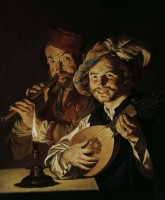
Matthias Stom "Musicians"

Pieter de Hooch "Mother and daughter near the barn" (1658). Amsterdam
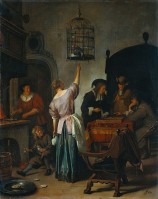
Jan Steen "Cage with a Parrot" (XVII century). Rijksmuseum, Amsterdam
But in other countries, the everyday genre still occupied a modest place and was the art of the "lower grade" (in Italy, France, Germany, Flanders, Spain). Even the appeal to the everyday genre of such great artists as Rubens or Velasquez did little to change the humiliating attitude towards everyday paintings.

Rubens and other artists "Animal farm in winter"
Household genre in the XVIII century
But gradually the attitude to the everyday genre is changing. There are artists who work mainly only in this genre. In France, these are Antoine Watteau, Francois Boucher, Nicolas Lancret, Sebastian Bourdon, Jean Baptiste Simeon Chardin, Claude Vernet, Jean-Honore Fragonard, Jean Baptiste Greuze and others.
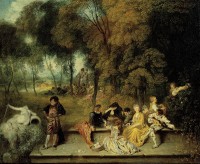
A. Watteau "Society in the Park" (1718-1719). Dresden gallery
The everyday paintings of this artist are usually poetic, in the simple and ordinary, he knows how to see something romantic, although the time for romanticism has not yet come.
True Image Elements real life are already visible in the paintings of artists from other countries: William Hogarth, Thomas Gainsborough (Great Britain), engraver D. Chodovetsky (Germany), J.P. Norblen (Poland), F. Goya (Spain), M. Shibanova, I. Ermeneva (Russia).
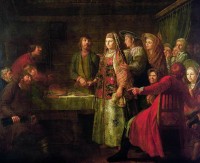
M. Shibanov "The Celebration of the Wedding Contract" (1777)
A new look at life
In the 19th century household genre is experiencing another heyday in different countries, the heroes of the plots of the paintings are those who were considered outcasts: the sick, the poor, slaves, prisoners - people of the social bottom. Previously, they were not noticed by art. Although captives and slaves appeared on canvases back in baroque art, they were only a decorative detail of the life of monarchs. These characters have acquired independent significance only now.
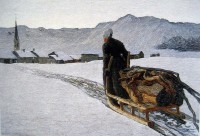
Giovanni Segantini "Return from the Forest" (Italy)
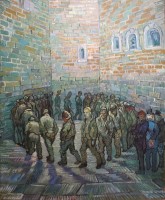
Vincent van Gogh Prisoner's Walk (Netherlands)

Gustave Courbet "Poor Peasant Woman in Winter" (France)

Vasily Vereshchagin "Visit to a prisoner by his family in Italy" (Russia)
Artists - supporters of the everyday genre: Theodore Rousseau, Honore Daumier, Edouard Manet, Edgar Degas, Pierre-Auguste Renoir, Paul Gauguin (France), M.A. Vrubel, I.E. Repin, N.A. Yaroshenko, V.A. Serov (Russia), K. Hokusai, Ando Hiroshige (Japan), Käthe Kollwitz, Adolf Menzel (Germany) and others.

P. A. Fedotov "Breakfast of an aristocrat" (1849-1850). State Tretyakov Gallery (Moscow)
Vanity, life for show, lies, outward brilliance - all these human weaknesses were well known to the artist and inspired him with disgust. Therefore, he has several paintings with a similar theme. Realistically, with great irony and a measure of pity, he shows the owner, taken by surprise by an uninvited guest. Why do we see pity here? When poverty is carefully hidden by such a method, it is always a pity. Pity for a person for whom the interior of his apartment is most important (so as not worse than others), the opinion of others about him, and so on. The artist does not show us a caricature of this aristocrat, he simply talks about the vain pettiness of people who tend to see the main thing in the secondary. And this minor so seizes a person that it becomes his essence. How he tries at the last moment to somehow disguise the evidence (his poverty), covering with a book a slice of black bread, which is the breakfast of this "aristocrat"!
Household genre in the era of symbolism
At the turn of the XIX-XX centuries. in the art of Symbolism and Art Nouveau, the everyday genre is somewhat modified: everyday scenes are depicted and interpreted as timeless symbols. In this regard, we recall the work of F. Hodler in Switzerland, V. E. Borisov-Musatov in Russia.
Further development of the everyday genre
In the 20th century, when social problems and contradictions in all areas of life aggravated, wars, revolutions, national liberation movements raged, people were clearly confused before present and future disasters, artists responded to these events and tried to analyze what was happening in their paintings using the artistic method. . In the XX century. E. Munch (Norway), Pablo Picasso (France), Ignacio Zuloaga (Spain), George Bellows, Rockwell Kent, Andrew Wyeth (USA), Boris Kustodiev, A.A. Plastov, A.A. Murashko, Z.E. Serebryakova, D.D. Zhilinsky, G.M. Korzhev, V.E. Popkov, F. Reshetnikov (Russia), Renato Guttuso (Italy), Diego Rivera (Mexico) and others.

A. Plastov "Elections of the Committee of the Poor"

D. Bellows "New York" (1911)
Works of the everyday genre often serve to express deep philosophical thoughts about life.

V. Popkov " Good man was grandmother Anisya "(1971-1973)
The unknown grandmother Anisya is a symbol of the immutability of the life of any person. The motif of an individual song (already finished, but still resounding in the hearts of loved ones) and epic choral singing sound in the picture. All this happens in the temple, and this temple is nature.
A genre of fine art dealing with daily private and public life (usually by a contemporary artist). Everyday ("genre") scenes, known in art since ancient times, stood out as a special genre in the feudal era (in the countries of the Far East) and during the formation of bourgeois society (in Europe). The heyday of the everyday genre of modern times is associated with the growth of democratic and realistic artistic trends, with the appeal of artists to the depiction of labor and folk life. Images on everyday topics were already present in primitive art (scenes of hunting, processions), in ancient oriental paintings and reliefs (images of the life of kings, nobles, artisans, farmers), in ancient Greek vase painting and reliefs, where they were often included in mythical compositions or scenes. afterlife. They occupied a significant place in Hellenistic and ancient Roman art (paintings, mosaics, sculpture). In the medieval art of Europe and Asia, genre scenes were often woven into religious and allegorical compositions (paintings, reliefs and miniatures). From the 4th century genre painting of the Far East (China, later Korea, Japan) developed.
During the Renaissance in Europe, religious and allegorical scenes in painting began to take on the character of a story about a real event, saturated with everyday details (Giotto, A. Lorenzetti in Italy, Jan van Eyck, R. Kampen, Gertgen tot Sint-Jans in the Netherlands), images appeared human labor activity (the Limburg brothers in France, M. Schongauer in Germany, F. Kossa in Italy). At the end of the XV - beginning of the XVI centuries. in the work of a number of artists, the everyday genre began to gradually stand apart (among the Venetians V. Carpaccio, Giorgione, J. Bassano, among the Netherlands C. Masseys, Luke of Leiden, P. Artsen). In the works of P. Brueghel in the Netherlands and J. Callot in France, the depiction of everyday scenes served to express social and philosophical ideas, affirm the joy of a peaceful life, and show social injustice and violence. The European household genre was finally formed in the 17th century. in the context of the struggle between the feudal and bourgeois structures, and asserted the private and folk way of life as a socially significant phenomenon. In various national schools of the XVII century. various types and principles of everyday genre have also developed, often asserted in the struggle against idealizing tendencies. In the work of Caravaggio in Italy, which influenced the development of realism in European art of the 17th century. ( cm. Caravagism), emphatically truthful, monumental depiction of scenes of the life of the lower classes in religious compositions was opposed to the idealizing principles of academism. The sublime poeticization of everyday motifs included in mythological and allegorical compositions, the assertion of the powerful vital forces contained in the people are characteristic of the works of P. P. Rubens and J. Jordaens in Flanders, which polemize with the principles of the official Baroque. In France, in the era of the dominance of the ideals of classicism, the Lenin brothers sought to show not only character traits appearance of the peasants, but also the moral value of their way of life. In Spain, D. Velazquez, referring to the scenes of court and folk life, revealed the relationship of man with environment, compared the prim refinement and class pride of the nobles with the healthy, natural beauty of ordinary people. The household genre occupied the leading position in the first bourgeois country - Holland, where its classical forms finally took shape. The poeticization of peasant and burgher life with its inherent intimate atmosphere of peaceful comfort is characteristic of A. van Ostade, K. Fabricius, P. de Hoch, J. Vermeer of Delft, G. Terborch, G. Metsu. In the second half of the XVII - early XVIII centuries. there has been a discrepancy between the democratic direction in the everyday genre, sometimes approaching the realization of the deep contradictions of life (the works of the Dutchman Rembrandt, the Fleming A. Brouwer, the Italians S. Rosa and J. M. Crespi), and idealizing art, which painted idyllic pictures of the life of peasants (D. Teniers in Flanders) and wealthy burghers (K. Netscher in Holland).
In the household genre of the XVIII century. in contrast to the idyllic pastorals and "gallant scenes" of rococo art (F. Boucher in France), a bourgeois family genre and anti-feudal everyday satire arose. The Englishman W. Hogarth laid the foundation for the socio-critical trend in the everyday genre (paintings and engravings ridiculing the mores of bourgeois society). In France, A. Watteau and J. O. Fragonard introduced emotional subtlety and sharpness of life observations into the everyday genre; truthfulness and sincerity marked the genre scenes of J. B. S. Chardin; the sentimental and didactic canvases of J. B. Greuze affirmed the norms of bourgeois morality. Realist tendencies manifested themselves in everyday paintings by artists from Italy (P. Longi), Germany (D. Chodovetsky), Sweden (P. Hilleström), and Poland (Ya. P. Norblin). Cheerful democracy, poetic brilliance in the perception of the world are imbued with early works on everyday topics by the Spaniard F. Goya. In Russia, the household genre developed from the second half of the 18th century. (I. I. Firsov, M. Shibanov, I. A. Ermenev) and was associated with a growing interest in the truthful depiction of the life of peasants. In the XVI-XVIII centuries. The everyday genre also flourished in the art of Asian countries - in the miniature of Iran, India, in the painting of Korea and especially in Japan (engravings by Kitagawa Utamaro, Katsushika Hokusai).
In the 19th century democratic artists considered the everyday genre as a field of criticism and exposure of unfair social relations, the assertion of the rights of the oppressed working people. In the first half of the century, an important role in the aesthetic affirmation of everyday life was played by the idyllic depiction of the life of the peasantry and urban democratic strata, captivating with poetic simplicity and touching sincerity (A. G. Venetsianov and the Venetian school in Russia, J. K. Bingham and W. S. Mount in the USA). , D. Wilkie in Scotland, representatives of the Biedermeier - G. F. Kersting and K. Spitzweg in Germany, F. Waldmüller in Austria, K. Köbke in Denmark). French romantics (T. Géricault, A. G. Dean) introduced the spirit of protest, generalization and psychological richness of the images of ordinary people into the everyday genre; O. Daumier in the middle of the XIX century. developed these searches, supplementing them with a high skill of social typification, a satirical exposure of the moral foundations of the bourgeois world.
In the middle and second half of the XIX century. characteristic features of the democratic everyday genre were life authenticity, the pathos of affirming the beauty and significance of a working person (G. Courbet and J. F. Millet in France, A. Menzel and V. Leibl in Germany, J. Fattori in Italy, J. Israels in Holland , W. Homer in the USA, sculptor C. Meunier in Belgium).
In the everyday genre of Russian critical realism, the exposure of the feudal way of life and sympathy for the disadvantaged were complemented by a deep and accurate penetration into the spiritual world of the characters, a detailed narrative, and a detailed dramatic development of the plot. These features, clearly manifested in the middle of the XIX century. in the paintings of P. A. Fedotov, full of burning mockery and pain, in the drawings of A. A. Agin and T. G. Shevchenko, were perceived in the 1860s. genre-democrats - V. G. Perov, P. M. Shmelkov, who combined direct and sharp journalism with a deep lyrical experience of the life tragedies of the peasantry and the urban poor. On this basis, the everyday genre of the Wanderers grew up, which played a leading role in their art, which exclusively fully and accurately reflected the folk life of the second half of the 19th century, intensely comprehending its social patterns. A detailed picture of the life of all strata of Russian society was given by G. G. Myasoedov, V. M. Maksimov, K. A. Savitsky, V. E. Makovsky, and - with special depth and scope - I. E. Repin, who showed not only barbarian oppression of the people, but also the fighters for its liberation, the mighty vitality hidden in the people. Such a breadth of the tasks of the genre picture often brought it closer to the historical composition. In the paintings of N. A. Yaroshenko, N. A. Kasatkin, S. V. Ivanov, A. E. Arkhipov in late XIX- early XX centuries. reflected the stratification of the countryside, the life of the working class. The everyday genre of the Wanderers found a wide response in the art of Ukraine (N. K. Pimonenko, K. K. Kostandi), Belarus (Yu. M. Pen), Latvia (Ya. I. Gabashvili, A. R. Mrevlishvili), Armenia (E. M. Tatevosyan) and others. The successes of democratic realism in the everyday genre of the 19th century. were associated with the formation and rise artistic culture many peoples in the course of their struggle for national and social liberation (M. Munkacsy in Hungary, K. Purkin in the Czech Republic, A. and M. Gerymsky and J. Chelmonsky in Poland, N. Grigorescu in Romania, I. Myrkvichka in Bulgaria, D Skutetsky in Slovakia, JF de Almeida Junior in Brazil, L. Romagnach in Cuba). Genre and everyday features are also manifested in the portrait landscape, historical and battle painting. At the same time, the everyday genre is sometimes imbued with religious-patriarchal or bourgeois morality, idyllic or entertaining features. A weakening of socially critical tendencies marked the work of a number of major genre painters (J. Bastien-Lepage, L. Lermitte in France, L. Knaus, B. Vautier in Germany, K. E. Makovsky in Russia). Artists associated with impressionism (E. Manet, E. Degas, O. Renoir in France), in the 1860s-80s. asserted a new type of genre painting, in which they sought to capture, as it were, a random, fragmentary aspect of life, a sharp characteristic of the appearance of characters, the unity of people and their natural environment. These trends gave impetus to a freer interpretation of the everyday genre, a direct pictorial perception of everyday scenes (M. Lieberman in Germany, E. Werenschell, K. Krogh in Norway, A. Zorn, E. Yousefson in Sweden, W. Sickert in Great Britain, T. Aikins in the USA, V. A. Serov, F. A. Malyavin, K. F. Yuon in Russia).
At the turn of the XIX-XX centuries. in the art of symbolism and the "modern" style, there is a break with the tradition of the everyday genre of the 19th century. Everyday scenes are treated as timeless symbols; the vital concreteness of the image gives way to monumental and decorative tasks (E. Munch in Norway, F. Hodler in Switzerland, P. Gauguin in France, V. E. Borisov-Musatov in Russia).
Traditions of realistic everyday genre of the 19th century. were picked up in the 20th century. artists who sought to reveal the contradictions of capitalism, to show resilience, inner strength and the spiritual beauty of people from the people (T. Steinlen in France, F. Brangvin in Great Britain, K. Kollwitz in Germany, D. Rivera in Mexico, J. Bellows in the USA, F. Maserel in Belgium, D. Derkovich in Hungary, N Balkan in Bulgaria, S. Lukyan in Romania, M. Galand in Slovakia, etc.). After the Second World War of 1939-45, this direction was continued by the masters of neorealism - R. Guttuso, A. Pizzinato and others in Italy, A. Fougeron and B. Taslitsky in France, Ueno Makoto in Japan. A characteristic feature of the everyday genre was the combination of acutely perceived characteristic features of everyday life with generalization, often symbolism of images and situations. In the liberating and developing countries of Asia and Africa, original schools of national everyday genres developed, rising from imitation and stylization to a deep generalized reflection of the way of life of their peoples (A. Sher-Gil, K. K. Hebbar in India, K. Affandi in Indonesia, M Sabri in Iraq, A. Tekle in Ethiopia, sculptors Kofi Antubam in Ghana, F. Idubor in Nigeria). Artists of modernist trends - pop art and hyperrealism - sometimes turn to everyday scenes, but their works do not go beyond passive fixation of fragments of reality taken out of the context of real life.
After the October Revolution of 1917, the everyday genre acquired in Soviet Russia new features, determined by the formation and development of socialist society, are historical optimism, the assertion of selfless free labor and a new way of life based on the unity of social and personal principles. This unity gave rise to a close connection between the everyday genre and the historical genre, which are often intertwined. household genre played an important role in the development Soviet art reflecting the building of socialism and communism, the formation of the spiritual world of the Soviet people in many ways. From the first years of Soviet power, artists (B. M. Kustodiev, I. A. Vladimirov) sought to capture the changes brought by the revolution to the life of the country. In the 20s. the AHRR association arranged a number of exhibitions dedicated to Soviet life, and its masters (E. M. Cheptsov, G. G. Ryazhsky, A. V. Moravov, B. V. Ioganson) created a number of reliable typical images showing new relationships between people. Artists of the OST association (A. A. Deineka, Yu. I. Pimenov) created a special type of paintings dedicated to construction, labor, and sports, in which they generally expressed new features of the appearance and life of Soviet people; poetic paintings of traditional and new life were made by P. V. Kuznetsov, M. S. Saryan, P. P. Konchalovsky, K. S. Petrov-Vodkin. household genre 30s affirmed a joyful, festive perception of life (S. V. Gerasimov, A. A. Plastov, T. G. Gaponenko, V. G. Odintsov, F. G. Krichevsky). The difficult life of the front and rear during the years of the Great Patriotic War of 1941-45 was reflected in the Soviet everyday genre (Yu. M. Neprintsev, B. M. Nemensky, A. I. Laktionov, V. N. Kostetsky, A. F. Pakhomov, L V. Soyfertis), enthusiasm for collective labor and social life, typical features of the everyday way of life in the postwar years (T. N. Yablonskaya, S. A. Chuikov, F. P. Reshetnikov, S. A. Grigoriev, U. M. Dzhaparidze , E. F. Kalnyn, L. A. Ilyina). Since the second half of the 50s. in the paintings of G. M. Korzhev, V. I. Ivanov, E. E. Moiseenko, V. E. Popkov, T. T. Salakhov, D. D. Zhilinsky, E. K. Iltner, I. A. Zarin, I. N. Klycheva, N. I. Andronov, A. P. and S. P. Tkachevs, T. R. Mirzashvili, S. M. Muradyan, engravings by G. F. Zakharov, V. M. Yurkunas, V V. Tolly the everyday life of the people appears rich and complex, full of great thoughts and experiences. Works of household genre of the 60-80s. often serve to express deep philosophical thoughts about life.
An important contribution to the development of the realistic everyday genre was made by the artists of the socialist countries, who vividly reflected the formation of new social relations in the life of their peoples, showing the characteristic features of national life (K. Baba in Romania, S. Venev in Bulgaria, V. Vomaka in the GDR, M. Benka , L. Fulla in Czechoslovakia, Nguyen Duc Nung in Vietnam, Kim Yongjun in the DPRK, Jiang Zhaohe in the PRC).
J. B. S. Chardin. "Laundress". Around 1737. Hermitage. Leningrad.
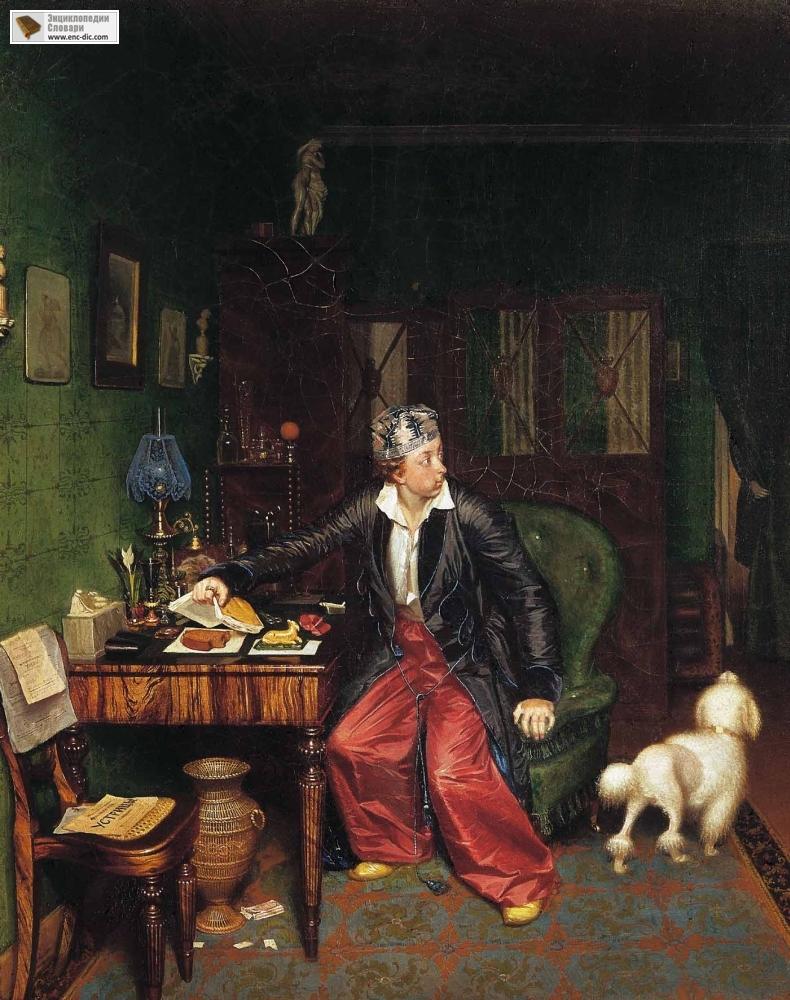
P. A. Fedotov. "Aristocrat's Breakfast" 1849 - 1850. Tretyakov Gallery. Moscow.

A. A. Plastov. Tractor Dinner. 1951. Irkutsk Regional Art Museum.
Literature: N. Apraksina, Household painting, L., 1959; B. M. Nikiforov, Genre painting, M., 1961; Russian genre painting XIX in. (Album of reproductions, M., 1961); Russian genre painting of the 19th - early 20th centuries, M., 1964; (E. Yu. Fekhner), Dutch genre painting of the 17th century. in the State Hermitage, M., 1979; Brieger L., Das Genrebild. Eine Entwicklung der bürgerlichen Malerei, Munch., (1922); Hütt W., Das Genrebild, Dresden, (1955).
The first paintings depicting scenes from life have been known since the time of rock art. Hunting for wild animals, cooking, ritual dances and sacrificial rites - these aspects of the daily existence of people were reflected in primitive drawings that have survived to this day.
However, the topic of everyday life was ignored by ancient masters, who believed that fine art should be sublime and refined, therefore there is no place for illustrations of everyday life in it.
The heyday of the everyday genre falls on the Renaissance, when values are rethought, and the main place in all types of art is given to man. Along with mythological subjects, many artists depict in their works ordinary people busy with daily activities.
However, everyday painting of this period is greatly embellished and elevated to the absolute - artists, by and large, sing of beauty human body, and everyday surroundings serve only as an addition, which is given secondary importance. Nevertheless, such artists as Peter Rubens and Diego Velázquez, Jan Vermeer of Delft, Jacob Jordaens and Adrian Van Ostade are considered to be the founders of the everyday genre in painting, which was finally formed only in the 18th century.
By the end of the 17th century, two main trends emerged in the everyday genre of fine art. In Europe, the rococo cult dominated, so it is not surprising that the artists tried to edit everyday scenes, to make them elegant and sophisticated. This is how “gallant painting” appeared, in which such masters as Karel Fabricius, Gerard Terborch, Antoine Watteau, Jean Baptiste Greuze, Jean Honore Fragonard, Francois Boucher and Jean Baptiste Simeon Chardin were very successful. Their paintings reflected, as a rule, the life of the upper class, and were distinguished by the photographic accuracy of details.
At the same time, a socio-critical trend in everyday painting developed in parallel, where reality was practically not embellished. Ordinary peasants became the heroes of the works of William Hogarth and Kim Hondo, Gustave Courbet and Giovanni Fattori, and everyday scenes with the participation of the aristocracy were often humorous.
In the second half of the 19th century, when a wave of impressionism swept over Europe, a new trend appeared in everyday painting, associated with the depiction of random scenes from people's lives. Fleeting sketches on the street turned into luxurious paintings, full of life and movement. To this day, the works of such painters as Edouard Manet, Auguste Renoir, Max Liebermann, Edgar Degas, Thomas Aikins and Anders Zorn are the standard of everyday genre in the visual arts.
Throughout the 20th century, everyday painting was an integral part of various trends and directions. The brightest representatives of avant-garde art and supporters of realism paid attention to her. However, this genre acquired an acute social orientation only in Russia thanks to Alexander Laktionov, Fedor Reshetnikov, Arkady Plastov, Boris Kustodiev, Gleb Savinov, Yuri Pimenov, Tatyana Yablonskaya and Ivan Vladimirov.
|
household genre
(French genre, German Sitten-bild) - a genre of fine art, defined by a range of topics and plots from a person's everyday life. Basically, these scenes are depicted on the canvases of painters, but they can also be seen on graphic sheets and in sculpture. Everyday events, captured by artists of different eras, acquaint us with the life of people of bygone times. The everyday genre flourished in European national schools in the 16th-17th centuries. The stage is filled with bright, sparkling fun national holiday in the painting by P. Brueghel the Elder (ill. 21). The Fleming P. Rubens on his canvases conveyed the features of life-affirming realism, the rough truth of village festivities. Dutch painters (G. Terborch, J. Vermeer) lovingly recreated the life of the most diverse strata of society (ill. 22). Gallant conversations acquired exquisite grace and slight irony in the paintings of French artists of the 18th century. (A. Watteau, F. Boucher, J.-B. Chardin, O. Fragonard). Later, from a simple fixation of phenomena, the artists move on to revealing the inner meaning and socio-historical content of everyday life. The French artists O. Daumier, G. Courbet and the Russian painters A. Venetsianov, P. Fedotov, V. Perov, I. Repin and all the Wanderers critically depicted social relations. Gradually, the boundaries between everyday, historical and battle genres were erased. The development of the everyday genre in the 20th century proceeds in complex and varied ways. Changeable situations and psychological nuances are available to him (E. Manet, E. Degas, O. Renoir in France), the symbolic meaning of being (P. Gauguin in France, V. Borisov-Musatov, K. Petrov-Vodkin in Russia), the glorification of simple life events (B. Ioganson, A. Deineka, A. Plastov) and much more.








